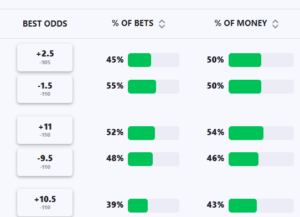Betting splits are one of those topics that get thrown around on social media and seem to stir a wild debate as to whether they are a useful tool or not. This makes it the perfect topic to delve in to! First, what are betting splits? Simply, they are a way to understand how the public is wagering on different sides of a bet in sports betting. They are typically presented in two forms: money splits and ticket splits.
What do the Two Values Represent?
 % of Money (Money Splits): This shows the percentage of the total amount wagered that is on each side of the bet. For instance, if 70% of the money is on Team A to win, and 30% is on Team B, this indicates that a larger amount of the total bets placed is predicting Team A will win. It’s important to note that this doesn’t reflect the number of bets, just the total amount of money wagered.
% of Money (Money Splits): This shows the percentage of the total amount wagered that is on each side of the bet. For instance, if 70% of the money is on Team A to win, and 30% is on Team B, this indicates that a larger amount of the total bets placed is predicting Team A will win. It’s important to note that this doesn’t reflect the number of bets, just the total amount of money wagered.
% of Bets (Ticket Splits): This, on the other hand, shows the percentage of the total number of bets placed on each side. For example, if 60% of the bets (tickets) are on Team A and 40% are on Team B, this means that more individual bets were placed on Team A, but it doesn’t necessarily indicate how much money was wagered.
What Values are Bettors Trying to Find in this Data?
When analyzing betting splits, bettors often look for certain indicators that can help them make more informed betting decisions. Here are some key aspects they consider:
1. Public vs. Sharp Money: Bettors try to differentiate between where the general public is putting their money (public money) and where the more informed, professional bettors (sharp money) are leaning. If a large percentage of the money is on one side but a larger number of bets are on the other, it may indicate sharp money is involved.
2. Line Movements: Bettors observe how betting lines move in response to betting splits. If a lot of money is on one side but the line is moving in the opposite direction, it could indicate that the sports books are extremely confident in their betting against the public. This could be an indication that you want to be on the same side that the sportsbooks are.
3. Percentage of Money vs. Percentage of Bets: Bettors compare the percentage of total money wagered against the percentage of total bets placed. A big disparity here can be insightful. For instance, if 80% of the money is on one team but only 50% of the bets, it implies that bigger bets (likely from more serious bettors) are on that team.
4. Consistency of Betting Splits Across Sportsbooks: Checking if the betting splits are consistent across various sportsbooks can provide additional insights. Different books have vastly different clienteles, and a different trends across them can be a strong indicator of a play one way or another..
In Conclusion…
It’s important to remember that while betting splits can provide valuable information, they are just one of many tools in a bettor’s arsenal. Successful betting involves a combination of analyzing betting splits, understanding the dynamics of the game, and often, a bit of intuition. To call betting splits completely useless is, I think, too extreme. If used properly and in conjunction with other data, it can be quite a useful tool